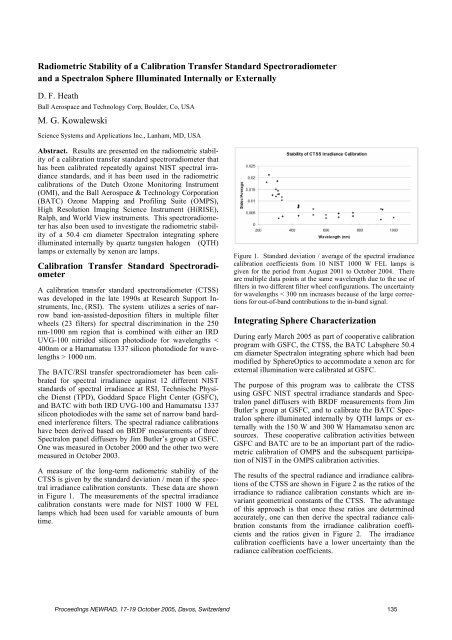Here - PMOD/WRC
Here - PMOD/WRC
Here - PMOD/WRC
Create successful ePaper yourself
Turn your PDF publications into a flip-book with our unique Google optimized e-Paper software.
Radiometric Stability of a Calibration Transfer Standard Spectroradiometer<br />
and a Spectralon Sphere Illuminated Internally or Externally<br />
D. F. Heath<br />
Ball Aerospace and Technology Corp, Boulder, Co, USA<br />
M. G. Kowalewski<br />
Science Systems and Applications Inc., Lanham, MD, USA<br />
Abstract. Results are presented on the radiometric stability<br />
of a calibration transfer standard spectroradiometer that<br />
has been calibrated repeatedly against NIST spectral irradiance<br />
standards, and it has been used in the radiometric<br />
calibrations of the Dutch Ozone Monitoring Instrument<br />
(OMI), and the Ball Aerospace & Technology Corporation<br />
(BATC) Ozone Mapping and Profiling Suite (OMPS),<br />
High Resolution Imaging Science Instrument (HiRISE),<br />
Ralph, and World View instruments. This spectroradiometer<br />
has also been used to investigate the radiometric stability<br />
of a 50.4 cm diameter Spectralon integrating sphere<br />
illuminated internally by quartz tungsten halogen (QTH)<br />
lamps or externally by xenon arc lamps.<br />
Calibration Transfer Standard Spectroradiometer<br />
A calibration transfer standard spectroradiometer (CTSS)<br />
was developed in the late 1990s at Research Support Instruments,<br />
Inc, (RSI). The system utilizes a series of narrow<br />
band ion-assisted-deposition filters in multiple filter<br />
wheels (23 filters) for spectral discrimination in the 250<br />
nm-1000 nm region that is combined with either an IRD<br />
UVG-100 nitrided silicon photodiode for wavelengths <<br />
400nm or a Hamamatsu 1337 silicon photodiode for wavelengths<br />
> 1000 nm.<br />
The BATC/RSI transfer spectroradiometer has been calibrated<br />
for spectral irradiance against 12 different NIST<br />
standards of spectral irradiance at RSI, Technische Physiche<br />
Dienst (TPD), Goddard Space Flight Center (GSFC),<br />
and BATC with both IRD UVG-100 and Hamamatsu 1337<br />
silicon photodiodes with the same set of narrow band hardened<br />
interference filters. The spectral radiance calibrations<br />
have been derived based on BRDF measurements of three<br />
Spectralon panel diffusers by Jim Butler’s group at GSFC.<br />
One was measured in October 2000 and the other two were<br />
measured in October 2003.<br />
A measure of the long-term radiometric stability of the<br />
CTSS is given by the standard deviation / mean if the spectral<br />
irradiance calibration constants. These data are shown<br />
in Figure 1. The measurements of the spectral irradiance<br />
calibration constants were made for NIST 1000 W FEL<br />
lamps which had been used for variable amounts of burn<br />
time.<br />
Figure 1. Standard deviation / average of the spectral irradiance<br />
calibration coefficients from 10 NIST 1000 W FEL lamps is<br />
given for the period from August 2001 to October 2004. There<br />
are multiple data points at the same wavelength due to the use of<br />
filters in two different filter wheel configurations. The uncertainty<br />
for wavelengths < 300 nm increases because of the large corrections<br />
for out-of-band contributions to the in-band signal.<br />
Integrating Sphere Characterization<br />
During early March 2005 as part of cooperative calibration<br />
program with GSFC, the CTSS, the BATC Labsphere 50.4<br />
cm diameter Spectralon integrating sphere which had been<br />
modified by SphereOptics to accommodate a xenon arc for<br />
external illumination were calibrated at GSFC.<br />
The purpose of this program was to calibrate the CTSS<br />
using GSFC NIST spectral irradiance standards and Spectralon<br />
panel diffusers with BRDF measurements from Jim<br />
Butler’s group at GSFC, and to calibrate the BATC Spectralon<br />
sphere illuminated internally by QTH lamps or externally<br />
with the 150 W and 300 W Hamamatsu xenon arc<br />
sources. These cooperative calibration activities between<br />
GSFC and BATC are to be an important part of the radiometric<br />
calibration of OMPS and the subsequent participation<br />
of NIST in the OMPS calibration activities.<br />
The results of the spectral radiance and irradiance calibrations<br />
of the CTSS are shown in Figure 2 as the ratios of the<br />
irradiance to radiance calibration constants which are invariant<br />
geometrical constants of the CTSS. The advantage<br />
of this approach is that once these ratios are determined<br />
accurately, one can then derive the spectral radiance calibration<br />
constants from the irradiance calibration coefficients<br />
and the ratios given in Figure 2. The irradiance<br />
calibration coefficients have a lower uncertainty than the<br />
radiance calibration coefficients.<br />
Proceedings NEWRAD, 17-19 October 2005, Davos, Switzerland 135
















